Illustrating the Competency-Based Education Definition
CompetencyWorks Blog
With much excitement, I’m eager to share our new graphic representation of the Aurora Institute definition of Competency-Based Education (CBE). The goal of this graphic is to show the relationship between the seven elements of the CBE definition. Like the definition itself, the graphic has undergone several iterations based on feedback from people in the CBE field. This includes participants in the Aurora Symposium 2023 CBE Leadership Forum, Aurora team members, and the CompetencyWorks Advisory Board.
As with any definition, how we interpret and put it into action matters greatly. No graphic is perfect, but I am hopeful we capture the essence of CBE clearly and concisely. As with the written definition, we need to unpack key words and ideas, which I will start to do with this blog post. Feedback is welcome and I invite you to join us in using the graphic to continue to raise awareness about CBE among various communities, including educators, policymakers, and the general public.
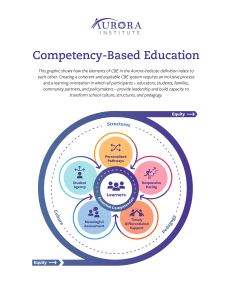 Defining CBE
Defining CBE
The Aurora CBE definition is not a one-size-fits-all prescription for students or any single school, district, or state. By CBE, we mean a transformational system of equitable learning based on evidence of learning, not how much time a learner spends in a classroom. We mean learning that the learner can use again in new contexts, beyond a test or unit of study in a moment in time when a student moves on even if they forget the answers they gave last week, or only demonstrated knowledge of 60 or 70% of the learning targets.
CBE is often described by terms including “personalized,” “student-centered,” “learner-centered,” “competency-based,” “mastery-based,” and “proficiency-based.” Sometimes we can reasonably say these are synonyms. Sometimes different terms mean the same thing. Sometimes, the same terms mean different things to different people. Building coherence through shared language and understanding of evidence-based practices that can be realized through multiple pathways to implementation is a core goal of CompetencyWorks.
Digging Deeper Into Each Element of the CBE Definition
For each element of the CBE definition, this section unpacks the key ideas in the graphic. The learner is at the center of a CBE system. From each individual’s experiences to the overall learning ecosystem, the purpose of a CBE system is to create the space and support for each learner to learn.
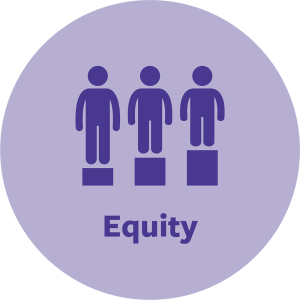 Strategies to ensure equity for all students are embedded in the culture, structure, and pedagogy of schools and education systems.
Strategies to ensure equity for all students are embedded in the culture, structure, and pedagogy of schools and education systems.
Equity drives the goals and the process for CBE. In a fully realized CBE system, educational equity is infused into the culture, systems, and pedagogy of a learning environment to produce equitable learning outcomes for each learner. The National Equity Project definition states:
Educational equity means that each child receives what they need to develop to their full academic and social potential. Working towards equity in schools involves:
- Ensuring equally high outcomes for all participants in our educational system; removing the predictability of success or failures that currently correlates with any social or cultural factor;
- Interrupting inequitable practices, examining biases, and creating inclusive multicultural school environments for adults and children; and
- Discovering and cultivating the unique gifts, talents and interests that every human possesses.
Equity is both an action – a way of working – and the ultimate goal of a CBE learning environment. An equity lens is an input into the work itself, through inclusive and transparent processes for vision, implementation, communication, partnership, and continuous learning which shape the enactment and ongoing effort to achieve equitable experiences and readiness for learners to thrive both now and in the future.
Culturally responsive practices and restorative practices are foundations for equitable culture, structures, and pedagogy in a CBE system. These are worthy endeavors in their own right, and an essential foundation for equitable CBE. A culture of belonging enables deep and lasting learning, not simply the performance of learning that often proves ephemeral beyond the test or unit assessment. Aligned structures and culturally responsive pedagogy foster equitable learning of the competencies.
Equity also becomes student-driven and generated as students experience supportive environments of belonging and high expectations. Bringing an equity lens to the other elements of the CBE definition – both at the student- and systems-level – brings equity to life. Each element creates the pedagogical approach, shapes the learning culture, and has its own structures to make them a reality. As the learner experiences a supportive culture, builds the skills to know themselves as a learner, and uses their agency to drive their learning, they interact and shape the culture, structures, and pedagogy of a CBE system.
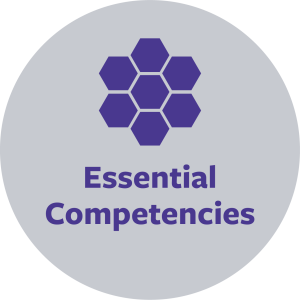 Rigorous, common expectations for learning (knowledge, skills, and dispositions) are explicit, transparent, measurable, and transferable.
Rigorous, common expectations for learning (knowledge, skills, and dispositions) are explicit, transparent, measurable, and transferable.
Rigorous, common expectations for learning, often called competencies, articulate the learning goals and form the backbone of the system. Competencies weave into all aspects of the system from the student-level navigation, through daily experiences, into the rhythm of each year, and the overall system itself. Competencies anchor the pedagogical framework that students are engaging with as they learn and demonstrate the competencies, making meaningful connections and choices along the way. Structures include clear learning, progressions or benchmarks for each competency. The competencies provide the knowledge, skills, and dispositions that shape the culture for working towards the vision and purpose of learning.
 Students are empowered daily to make important decisions about their learning experiences, how they will create and apply knowledge, and how they will demonstrate their learning.
Students are empowered daily to make important decisions about their learning experiences, how they will create and apply knowledge, and how they will demonstrate their learning.
While we each ultimately have agency that we can use in our lives, we also need opportunities to develop the skills and mindsets to exercise our agency effectively. Creating the space to practice intentionally encourages students to see that they drive their own learning and hold the power in how to use their learning. One of the most transformative changes in personalized, competency-based education is the cultural shift from expecting students to be compliant, passive learners to engaging them as productive, active learners.
As students become active learners with an increasing ability to guide their learning, roles and power dynamics in the classroom change and enable student-centered pedagogy to blossom. Structures that support student agency and daily empowerment include personalized learning plans to guide daily and longer-term goal setting and reflection, advisory systems that encourage relationship-building and social-emotional learning, and student-led conferences.
 Assessment is a meaningful, positive, and empowering learning experience for students that yields timely, relevant, and actionable evidence.
Assessment is a meaningful, positive, and empowering learning experience for students that yields timely, relevant, and actionable evidence.
Local assessment systems allow students to develop, demonstrate, and get feedback on the essential competencies of a CBE system. Specifically, student performance assessment allows students to show what they know in relevant, rigorous ways. Assessment provides data that help students, teachers, and families to know how students are doing in their learning. Educators develop assessment literacy to create, assess, and calibrate evidence of learning. Meaningful assessment can take many forms; for example, it can be embedded within project- or work-based learning. Opportunities for feedback and to show growth through multiple demonstrations in different contexts ground the culture and routines of assessment. Over the rhythm of a term or school year, capstone projects, exhibitions and demonstrations of learning, and portfolio assessments create culminating experiences and moments of summative assessment and reflection.
 Students receive timely, differentiated support based on their individual learning needs.
Students receive timely, differentiated support based on their individual learning needs.
Designing to provide each student with timely, differentiated support means being clear about the learning goals and pathways in your system. It also means fostering relationships with each learner to know who they are and collaborate with learners to personalize their learning. CBE systems create the structures and routines to monitor the growth of every student’s learning. This allows educators to respond quickly when students are not progressing. Communicating progress with transparency and providing data in real time helps educators to meet students where they are in their zones of proximal development to help them master learning targets and build the competencies they need for college, career, and life.
 Students progress based on evidence of mastery, not seat time.
Students progress based on evidence of mastery, not seat time.
At the heart of competency-based systems, decisions about student learning and advancement are made based on their demonstrated level of mastery – rather than their age or a standardized time frame. Students may progress more quickly in some academic domains, while taking more time in areas that are more challenging for them. Responsiveness to where a student is in their learning and where they are ready to grow guides pacing. Rather than a checklist mentality, where a student demonstrates something and moves on, the focus is on growing over time and deepening one’s ability to apply knowledge and skills in new scenarios.
 Students learn actively using different pathways and varied pacing.
Students learn actively using different pathways and varied pacing.
CBE learning models move beyond one-size-fits-all curriculum and learning experiences to provide flexible, personalized pathways. In a fully transformational CBE model, learning can happen anytime, anywhere and the learner drives the pacing as they demonstrate growth and mastery. Each learning community also takes its own path to creating personalized pathways. Choice and personalization can happen along a continuum of increasing choice and variety with options such as choice within project-based learning or a performance assessment, independent passion or capstone projects, community-based projected, experiential and place-based learning, work-based learning, and early college or dual enrollment.
A Learning Management System (LMS) and comprehensive learner record can be essential structures to effectively manage learning and document what students have learned and where they have demonstrated mastery. Incorporating Universal Design for Learning (UDL) and culturally responsive strategies support equitable access to active and personalized learning that reflects each student’s unique needs, strengths, interests, goals, and pace.
Visualizing the Future
CompetencyWorks aims to accelerate the use of high-quality competency-based models as a strategy for educational equity that enables every child to succeed and thrive. I hope this new graphic adds to your tool box as you imagine and chart your path to CBE implementation with integrity.
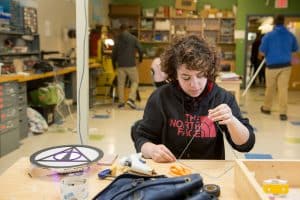
Learn More
- Implementation with Integrity
- CBE Starter Pack 1: Students are Empowered Daily
- CBE Starter Pack 2: Meaningful Assessment
- CBE Starter Pack 3: Timely, Differentiated Support
- CBE Starter Pack 4: Progress Based on Mastery
- CBE Starter Pack 5: Learn Actively With Varied Pathways and Pacing
- CBE Starter Pack 6: Equity Strategies Drive Culture, Structures, and Pedagogy
- CBE Starter Pack 7: Establish Rigorous, Common Expectations with Meaningful Competencies
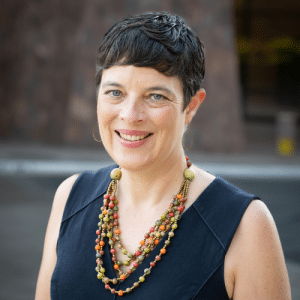 Laurie Gagnon is the CompetencyWorks Program Director at the Aurora Institute. She leads the work of sharing promising practices shaping the future of K-12 personalized, competency-based education (CBE). She is grateful to Acacia Betancourt for bringing the new graphic to life. Laurie lives in Somerville, MA with her partner, young son, and cat. She hopes to contribute to the strategic, student-centered transformation of her own local public school district.
Laurie Gagnon is the CompetencyWorks Program Director at the Aurora Institute. She leads the work of sharing promising practices shaping the future of K-12 personalized, competency-based education (CBE). She is grateful to Acacia Betancourt for bringing the new graphic to life. Laurie lives in Somerville, MA with her partner, young son, and cat. She hopes to contribute to the strategic, student-centered transformation of her own local public school district.